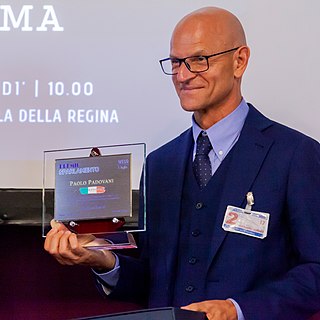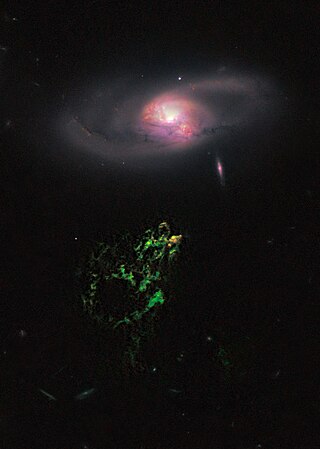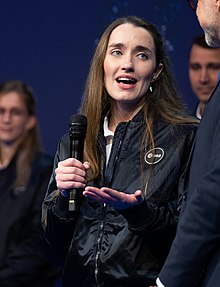
A quasar is an extremely luminous active galactic nucleus (AGN). It is sometimes known as a quasi-stellar object, abbreviated QSO. The emission from an AGN is powered by a supermassive black hole with a mass ranging from millions to tens of billions of solar masses, surrounded by a gaseous accretion disc. Gas in the disc falling towards the black hole heats up and releases energy in the form of electromagnetic radiation. The radiant energy of quasars is enormous; the most powerful quasars have luminosities thousands of times greater than that of a galaxy such as the Milky Way. Quasars are usually categorized as a subclass of the more general category of AGN. The redshifts of quasars are of cosmological origin.
An active galactic nucleus (AGN) is a compact region at the center of a galaxy that emits a significant amount of energy across the electromagnetic spectrum, with characteristics indicating that this luminosity is not produced by the stars. Such excess, non-stellar emissions have been observed in the radio, microwave, infrared, optical, ultra-violet, X-ray and gamma ray wavebands. A galaxy hosting an AGN is called an active galaxy. The non-stellar radiation from an AGN is theorized to result from the accretion of matter by a supermassive black hole at the center of its host galaxy.

Seyfert galaxies are one of the two largest groups of active galaxies, along with quasar host galaxies. They have quasar-like nuclei with very high surface brightnesses whose spectra reveal strong, high-ionisation emission lines, but unlike quasars, their host galaxies are clearly detectable.

A radio galaxy is a galaxy with giant regions of radio emission extending well beyond its visible structure. These energetic radio lobes are powered by jets from its active galactic nucleus. They have luminosities up to 1039 W at radio wavelengths between 10 MHz and 100 GHz. The radio emission is due to the synchrotron process. The observed structure in radio emission is determined by the interaction between twin jets and the external medium, modified by the effects of relativistic beaming. The host galaxies are almost exclusively large elliptical galaxies. Radio-loud active galaxies can be detected at large distances, making them valuable tools for observational cosmology. Recently, much work has been done on the effects of these objects on the intergalactic medium, particularly in galaxy groups and clusters.

A supermassive black hole is the largest type of black hole, with its mass being on the order of hundreds of thousands, or millions to billions, of times the mass of the Sun (M☉). Black holes are a class of astronomical objects that have undergone gravitational collapse, leaving behind spheroidal regions of space from which nothing can escape, including light. Observational evidence indicates that almost every large galaxy has a supermassive black hole at its center. For example, the Milky Way galaxy has a supermassive black hole at its center, corresponding to the radio source Sagittarius A*. Accretion of interstellar gas onto supermassive black holes is the process responsible for powering active galactic nuclei (AGNs) and quasars.

The Giant Metrewave Radio Telescope (GMRT), located near Narayangaon, Pune in India, is an array of thirty fully steerable parabolic radio telescopes of 45 metre diameter, observing at metre wavelengths. It is the largest and most sensitive radio telescope array in the world at low frequencies. It is operated by the National Centre for Radio Astrophysics (NCRA), a part of the Tata Institute of Fundamental Research, Mumbai. It was conceived and built under the direction of Govind Swarup during 1984 to 1996. It is an interferometric array with baselines of up to 25 kilometres (16 mi). It was recently upgraded with new receivers, after which it is also known as the upgraded Giant Metrewave Radio Telescope (uGMRT).

Paolo Padovani is an Italian astronomer working at the European Southern Observatory, specializing in the study of Active galactic nuclei including the study of quasars and blazars, evolution and multifrequency studies and extragalactic backgrounds. In 2004 he and several other astronomers discovered 30 supermassive blackholes at the European Astrophysical Virtual Observatory using pioneering techniques.
In astronomy, the intracluster medium (ICM) is the superheated plasma that permeates a galaxy cluster. The gas consists mainly of ionized hydrogen and helium and accounts for most of the baryonic material in galaxy clusters. The ICM is heated to temperatures on the order of 10 to 100 megakelvins, emitting strong X-ray radiation.

Hanny's Voorwerp is a type of astronomical object called a quasar ionization echo. It was discovered in 2007 by Dutch schoolteacher Hanny van Arkel while she was participating as a volunteer in the Galaxy Zoo project, part of the Zooniverse group of citizen science websites. Photographically, it appears as a bright blob close to spiral galaxy IC 2497 in the constellation Leo Minor.

Green bean galaxies (GBGs) are very rare astronomical objects that are thought to be quasar ionization echos. They were discovered by Mischa Schirmer and colleagues R. Diaz, K. Holhjem, N.A. Levenson, and C. Winge. The authors report the discovery of a sample of Seyfert-2 galaxies with ultra-luminous galaxy-wide narrow-line regions (NLRs) at redshifts z=0.2-0.6.

NGC 3862 is an elliptical galaxy located 300 million light-years away in the constellation Leo. Discovered by astronomer William Herschel on April 27, 1785, NGC 3862 is an outlying member of the Leo Cluster.

iPTF14hls is an unusual supernova star that erupted continuously for about 1,000 days beginning in September 2014 before becoming a remnant nebula. It had previously erupted in 1954. None of the theories nor proposed hypotheses fully explain all the aspects of the object.
Red nuggets is the nickname given to rare, unusually small galaxies packed with large amounts of red stars that were originally observed by Hubble Space Telescope in 2005 in the young universe. They are ancient remnants of the first massive galaxies. The environments of red nuggets are usually consistent with the general elliptical galaxy population. Most red nuggets have merged with other galaxies, but some managed to stay unscathed.
Katherine Gudrun Isaak is a British astrophysicist and the Project Scientist for the European Space Agency Characterising Exoplanet Satellite mission (CHEOPS). She is based at European Space Research and Technology Centre.

The Teacup galaxy, also known as the Teacup AGN or SDSS J1430+1339 is a low redshift type 2 quasar, showing an extended loop of ionized gas resembling a handle of a teacup, which was discovered by volunteers of the Galaxy Zoo project and labeled as a Voorwerpje.

NeVe 1 is a supergiant elliptical galaxy, which is the central, dominant member and brightest cluster galaxy (BCG) of the Ophiuchus Cluster. It lies at a distance of about 411 million light-years away from Earth and is located behind the Zone of Avoidance region in the sky. It is the host galaxy of the Ophiuchus Supercluster eruption, the most energetic astronomical event known.

François Hammer, born on 19 November 1958, is a French astrophysicist. He has been an astronomer at the Paris Observatory since 1987 and was an astronomer attached to the Canada-France-Hawaii Telescope between 1991 and 1992.













